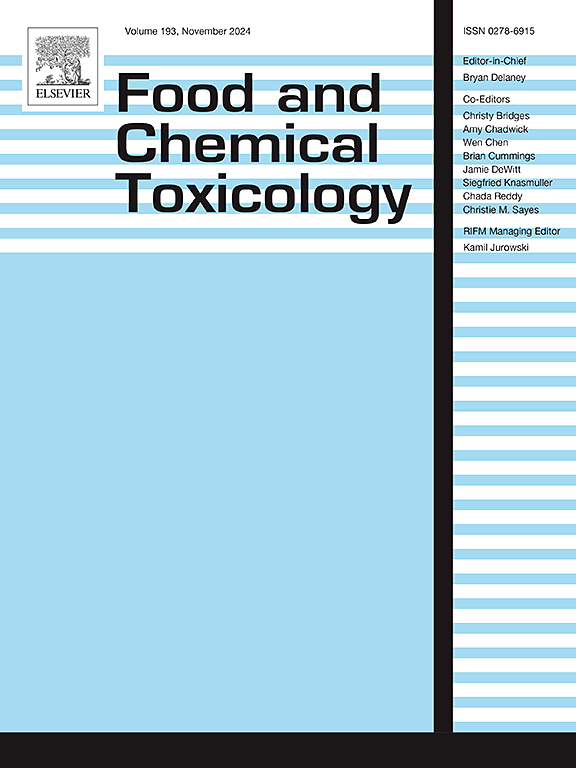The cytotoxicity of synthetic cathinones on dopaminergic-differentiated SH-SY5Y neuroblastoma cell line: Exploring the role of β-keto metabolic reduction
IF 3.5
3区 医学
Q2 FOOD SCIENCE & TECHNOLOGY
引用次数: 0
Abstract
Synthetic cathinones, a major class of new psychoactive substances (NPS), pose a growing public health threat due to their widespread recreational use, particularly among young people. While metabolism significantly influences xenobiotic toxicity, its role in synthetic cathinone neurotoxicity remains underexplored. Similarly to the other cathinones included in this study, 4-CBC and 3-CBC were rapidly metabolized in vitro (t1/2 < 20 min), producing dihydro-metabolites as major products. To evaluate the toxicological relevance of this transformation, we synthesized ten dihydro-metabolites and assessed their cytotoxicity in differentiated SH-SY5Y cells. Most dihydro-derivatives were more neurotoxic than their parent cathinones, with dihydro-3-CBC, dihydro-3-CIC, dihydro-4-CIC, and dihydro-4-CBC displaying the lowest LC50 values (0.24–0.28 mM). All dihydro-metabolites exhibited higher Hill slopes, indicating that small increases in their formation might result in significant toxicological consequences. Dihydro-α-PHP showed the steepest slope, raising concern given the high use and seizure rates of α-PHP in the Portuguese Azores and Madeira islands. These findings highlight the importance of β-ketone reduction in synthetic cathinone toxicity and suggest that similar metabolic transformations may contribute to the toxicity of other chemical agents.

合成卡西酮对多巴胺能分化的SH-SY5Y神经母细胞瘤细胞株的细胞毒性:探讨β-酮代谢减少的作用
合成卡西酮是一类主要的新型精神活性物质,由于其广泛用于娱乐,特别是在年轻人中,对公众健康构成越来越大的威胁。虽然代谢显著影响外源性毒性,但其在合成卡西酮神经毒性中的作用仍未得到充分探讨。与本研究纳入的其他卡西酮相似,4-CBC和3-CBC在体外代谢迅速(t1/2 < 20 min),主要产物为二氢代谢物。为了评估这种转化的毒理学相关性,我们合成了十种二氢代谢物,并评估了它们在分化的SH-SY5Y细胞中的细胞毒性。大多数二氢衍生物比其母体卡西酮更具有神经毒性,其中二氢-3- cbc、二氢-3- cic、二氢-4- cic和二氢-4- cbc的LC50值最低(0.24-0.28 mM)。所有的二氢代谢物都表现出较高的Hill斜率,表明其形成的微小增加可能导致显著的毒理学后果。二氢-α-PHP的斜率最大,这引起了人们的关注,因为α-PHP在葡萄牙亚速尔群岛和马德拉群岛的使用率和缉获率很高。这些发现强调了β-酮减少在合成卡西酮毒性中的重要性,并表明类似的代谢转化可能有助于其他化学制剂的毒性。
本文章由计算机程序翻译,如有差异,请以英文原文为准。
求助全文
约1分钟内获得全文
求助全文
来源期刊

Food and Chemical Toxicology
工程技术-毒理学
CiteScore
10.90
自引率
4.70%
发文量
651
审稿时长
31 days
期刊介绍:
Food and Chemical Toxicology (FCT), an internationally renowned journal, that publishes original research articles and reviews on toxic effects, in animals and humans, of natural or synthetic chemicals occurring in the human environment with particular emphasis on food, drugs, and chemicals, including agricultural and industrial safety, and consumer product safety. Areas such as safety evaluation of novel foods and ingredients, biotechnologically-derived products, and nanomaterials are included in the scope of the journal. FCT also encourages submission of papers on inter-relationships between nutrition and toxicology and on in vitro techniques, particularly those fostering the 3 Rs.
The principal aim of the journal is to publish high impact, scholarly work and to serve as a multidisciplinary forum for research in toxicology. Papers submitted will be judged on the basis of scientific originality and contribution to the field, quality and subject matter. Studies should address at least one of the following:
-Adverse physiological/biochemical, or pathological changes induced by specific defined substances
-New techniques for assessing potential toxicity, including molecular biology
-Mechanisms underlying toxic phenomena
-Toxicological examinations of specific chemicals or consumer products, both those showing adverse effects and those demonstrating safety, that meet current standards of scientific acceptability.
Authors must clearly and briefly identify what novel toxic effect (s) or toxic mechanism (s) of the chemical are being reported and what their significance is in the abstract. Furthermore, sufficient doses should be included in order to provide information on NOAEL/LOAEL values.
 求助内容:
求助内容: 应助结果提醒方式:
应助结果提醒方式:


